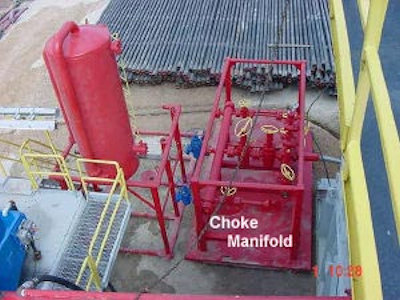Installing and Testing BOPs, Accumulator, and Choke Manifold
In the well control system installation process, the blowout preventer (BOP), accumulator and choke manifold are installed by the rig crew after the surface casing is set and cemented.
The BOP is one or more valves installed at the wellhead to prevent the escape of pressure either in the annular space between the casing and the drill pipe or in open hole (for example, hole with no drill pipe) during drilling or completion operations.
The accumulator and choke manifold have been set into place during rigging up and now need to be hooked up and tested.
The accumulator is a storage device for nitrogen pressurized hydraulic fluid, which is used in operating the blowout preventers.
The choke manifold is the arrangement of piping and special valves, called chokes, through which drilling mud is circulated when the blowout preventers are closed to control the pressures encountered during a kick.
- The choke line valve is used to redirect the mud from the well bore to the choke manifold during a kick.
- The kill line valve is used to direct drilling fluid to the BOP during a kick.
The BOPs, accumulators, and choke manifold should be regularly tested and properly maintained.
We will discuss the potential hazards and possible solutions in the next tab.
Knowledge Check Choose the best answer for the question.
9-4. Which of the following is a storage device for nitrogen pressurized hydraulic fluid?
You forgot to answer the question!

